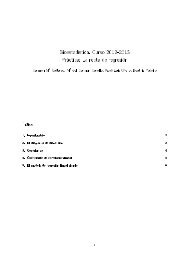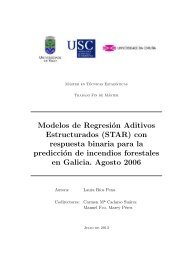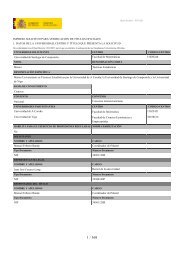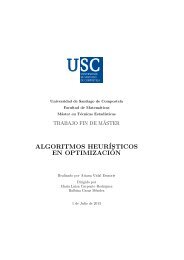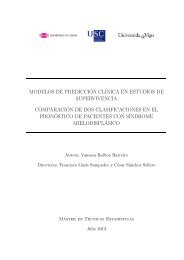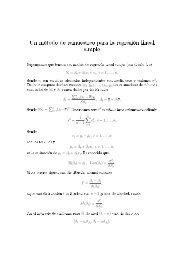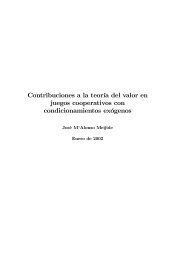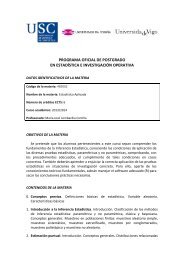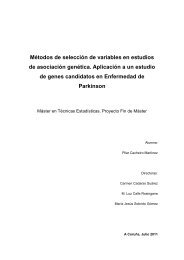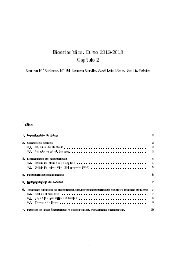Bootstrap independence test for functional linear models
Bootstrap independence test for functional linear models
Bootstrap independence test for functional linear models
Create successful ePaper yourself
Turn your PDF publications into a flip-book with our unique Google optimized e-Paper software.
In terms of power, when r = 0.5 the results <strong>for</strong> all the methods are similar, except <strong>for</strong> T 2,n <strong>for</strong> whichthe empirical power decreases drastically, above all when k n increases (this effect is also observed<strong>for</strong> r = 1 and r = 2). This fact seems to be due to the construction of T 2,n since this <strong>test</strong> statisticis the only one which does not involve the estimation of σ 2 . In addition, the power of T 1,n also fallsabruptly when T ∗(b)1,n is considered, n is small and k n is very large.A similar situation can be observed when r = 1 and r = 2. In the latter it can be seen that theempirical power is smaller <strong>for</strong> all the methods in general, being obtained an important loss of powerwhen the sample is small (n = 50), and k n increases and/or α decreases (see Table 4 on page 14).Furthermore, in this case, it can be seen that the empirical power relies heavily on the selected k nvalue. Hence, the advantage of using T 3,n or T 3s,n is that they do not require the selection of anyparameter and they are competitive in terms of power. Nevertheless, it also seems that an adequatek n selection can make T 1,n obtain larger empirical power than T 3,n or T 3s,n in some cases.n50100N (0, 2)T ∗(a)1,n T ∗(b)1,n T2,n∗α k T3,n∗ T 3s,n∗ n k n k n k n5 10 20 5 10 20 5 10 20 5 10 2020% 100.0 100.0 100.0 100.0 100.0 100.0 100.0 100.0 98.2 66.6 3.6 0.2 100.0 100.010% 100.0 100.0 100.0 100.0 100.0 99.8 100.0 99.8 89.6 33.6 0.8 0.0 100.0 100.05% 100.0 100.0 99.8 100.0 100.0 99.6 100.0 99.0 59.6 16.6 0.2 0.0 99.2 99.21% 100.0 100.0 99.6 99.6 97.6 94.6 95.2 67.6 2.6 2.2 0.0 0.0 87.8 92.420% 100.0 100.0 100.0 100.0 100.0 100.0 100.0 100.0 100.0 97.0 7.8 0.0 100.0 100.010% 100.0 100.0 100.0 100.0 100.0 100.0 100.0 100.0 100.0 86.4 2.2 0.0 100.0 100.05% 100.0 100.0 100.0 100.0 100.0 100.0 100.0 100.0 100.0 67.8 1.0 0.0 100.0 100.01% 100.0 100.0 100.0 100.0 100.0 100.0 100.0 100.0 99.8 21.6 0.2 0.0 100.0 100.0Table 3: For r = 1, comparison of the empirical power <strong>for</strong> T 1,n (using the asymptotic distribution N (0, 2)and the bootstrap distributions of T ∗(a) ∗(b)1,n and T1,n ), T 2,n (using the bootstrap distribution of T2,n), ∗ T 3,n(using the bootstrap distribution of T3,n) ∗ and its studentized version, T 3s,n (using the bootstrap distributionof T3s,n).∗n50100N (0, 2) T ∗(a)1,n T ∗(b)1,n T2,n∗α k T3,n∗ T 3s,n∗ n k n k n k n5 10 20 5 10 20 5 10 20 5 10 2020% 85.4 75.6 66.8 89.0 81.2 77.2 89.0 76.8 51.4 34.0 11.8 7.2 90.4 89.810% 80.0 68.6 56.4 79.4 68.6 59.4 76.4 57.4 20.2 16.6 4.0 2.4 79.0 79.05% 74.4 62.2 48.4 67.4 51.6 43.6 60.8 37.8 6.2 10.4 1.0 0.4 67.8 67.21% 67.4 51.4 35.6 40.0 26.4 20.2 25.4 6.0 0.0 0.8 0.0 0.0 34.4 39.020% 99.8 98.8 94.6 100.0 99.8 98.0 100.0 99.2 94.2 60.0 14.6 7.6 99.8 99.810% 99.6 96.6 91.2 99.6 97.2 93.6 99.6 96.0 82.4 34.2 6.2 2.0 97.8 97.45% 99.6 95.6 85.8 97.8 94.0 85.8 97.2 90.4 64.6 18.0 2.8 0.4 94.4 94.41% 97.6 91.4 75.4 88.2 76.4 64.0 85.2 63.4 26.2 2.2 0.8 0.0 79.2 82.4Table 4: For r = 2, comparison of the empirical power <strong>for</strong> T 1,n (using the asymptotic distribution N (0, 2)and the bootstrap distributions of T ∗(a) ∗(b)1,n and T1,n ), T 2,n (using the bootstrap distribution of T2,n), ∗ T 3,n(using the bootstrap distribution of T3,n) ∗ and its studentized version, T 3s,n (using the bootstrap distributionof T3s,n).∗14



